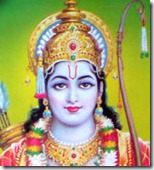 “Tulsidas humbly asks to have trust in Rama, to take strength in Rama, and to have complete faith in Rama’s holy name, the remembrance of which brings auspiciousness, well-being and fortunes.” (Dohavali, 38)
“Tulsidas humbly asks to have trust in Rama, to take strength in Rama, and to have complete faith in Rama’s holy name, the remembrance of which brings auspiciousness, well-being and fortunes.” (Dohavali, 38)
rāma bharoso rāma bala rāma nāma bisvāsa |
sumirata subha mangala kusala māngata tulasīdāsa ||
Goswami
Tulsidas is such a famous poet, his works are so widely sung, honored, read and studied, that his works pique the interests of the full spectrum of philosophers, scholars and religionists. Some have their own ultimate conclusions about spirituality - their primary guiding force in life, that one wish which when fulfilled will ideally bring them peace of mind and tranquility - so they try to attach themselves to the famous Vaishnava poet, who is best known for his devotion to Rama. Others will try to cut him down, as he is the “top dog” when it comes to popularity and influence in bhakti literature. If his works can be discredited, or his doctrine shown to be invalid, then hopefully others will stop reading his books and singing his songs. But despite the external viewpoints, Tulsidas’ doctrine, his foremost desire, or underlying philosophy, remains quite simple and straightforward. In this very nice verse from his
Dohavali, the poet makes his cherished wish perfectly clear, leaving no room for doubt as to his intentions or the primary influence to his devotional efforts.
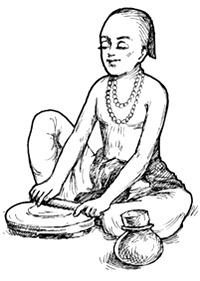
How can the poet’s teachings be interpreted otherwise? The Vedas, which are the original spiritual tradition of India dating back since time immemorial, provide different roadmaps towards ultimate salvation, the emancipation of the soul. Though religions today are often associated with dogmas, sectarian principles and sentimentalist traditions, the process of genuine self-realization can be described in scientific terms. Therefore the original Vedas never touch on different factions, for the concept of “
religion” is not even mentioned. At the heart of self-realization is dharma, or an occupational duty. Since this duty never changes, it is known as
sanatana, which means “that which has no beginning and no end”. At its root, dharma is an essential characteristic, so it can apply to different areas of endeavor. For instance, a doctor’s dharma is his ability to heal the sick. Therefore, whatever steps he needs to take to ensure that he can maintain this characteristic also becomes his dharma. This is how the term “dharma” can also be used to describe occupational duties, which can then be codified into law codes, regulations or recommended rituals.
Though there are different characteristics depending on specific desire, time and circumstance, there is one trait that trumps all others. At the heart of individuality is the spirit soul, the
atma. Irrespective of body type, if life is present, there must be spirit. If there is an instance of life, there must be a soul residing within the living body form. Depending on the type of encasing assumed, different external characteristics result. For instance, tigers are prone towards eating other animals, while
cows can survive on just eating grass. These features are specific to the outer covering and not related to the soul in any way.
Irrespective of the form assumed, the soul’s primary characteristic remains that of a lover of God. This is a law of spiritual science that transcends religious systems and dogmatic traditions. Just as the laws of gravity operate equally on all objects, even if people don’t believe in them, the properties of the soul remain intact even if not a single person is cognizant of them. The system of religion, or regulative practice, that recharges the soul’s most dominant characteristic, that makes the spiritual loving propensity take over the particular life form, thus becomes the highest dharma, or that occupational duty which cannot ever change in effectiveness.
For the human being to reach the point of reawakening their essential characteristic, some effort and conviction are required. At the time of birth identification is taken solely from the particular body accepted and the relationship it has to parents, friends and relatives. Just as it takes education to be able to read, write, and do arithmetic, it takes training under a bona fide spiritual guide to become familiar with the laws of spiritual science and then put them to good use.
“The steadily devoted soul attains unadulterated peace because he offers the result of all activities to Me; whereas a person who is not in union with the Divine, who is greedy for the fruits of his labor, becomes entangled.” (Lord Krishna,
Bhagavad-gita, 5.12)
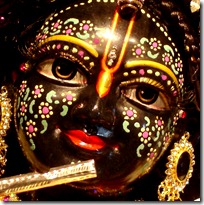
Though the specific practices implemented from a spiritual education can be many, the Vedas place them into three primary groups. One method is to follow fruitive activity and sacrifice the results to the object of worship, the Supreme Lord. The individual soul’s ultimate characteristic is to be a lover of God, and God’s position is to be loved. He too is spirit, but the quantitative presence of His features is much larger. He is the big soul, or Supersoul, while we are individual souls. In
karma-yoga, the results of actions that normally benefit the body of the individual soul are sacrificed for the benefit of the Supreme Lord. Detachment steadily increases and the worker ideally realizes that their business is to serve God and no one else.
Another pathway towards attaining one’s dharma is jnana-yoga, wherein the individual learns about the different manifestations of matter and the properties of spirit. This discipline basically abstracts every type of activity. For instance, if we see one person playing baseball and another person playing soccer, we can abstract their activities into one category: playing sports. If we were to remove the nuance from every activity of the conditioned entities, we would learn that all material behavior is driven by an illusory energy known as maya. Maya is the agent that envelops the soul in delusion, keeping the foremost characteristic of the soul in a dormant state. The aim of jnana-yoga is to break through the illusion by understanding what is matter and what is spirit. As a result, the position of the Supreme Lord can be better understood.
Though there is another category of activity generally thrown into the mix, it is actually a combination of karma-yoga and jnana-yoga. Mystic meditation involves austerity and also concentration on the Absolute Truth. By remaining in particular sitting postures for long hours at a time and blocking out the influence of the senses, the soul coupled with the body can do many wonderful things. The ideal aim is still to break free of the conditioned mindset adopted at the time of birth.
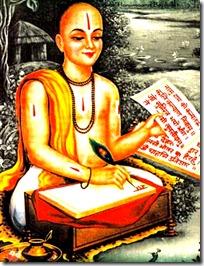
The third pathway is actually the culmination of every other system of maintenance. Bhakti-yoga is all-inclusive, as yoga is meant to result in pure love for God. For those who are already on the platform of pure love for Godhead, there is no need to explicitly practice any other type of yoga. Goswami Tulsidas was a proponent of bhakti-yoga, as he was practicing it all the time. What’s so wonderful about loving God is that when you act out your love, you don’t even consider that you are doing yoga. Since it is the dharma of the soul to be a lover of God, when activities are driven by this characteristic, there is no consideration given to the type of engagement adopted or the meaning behind it. In the spiritual world, where the influence of maya is absent, there is no such thing as bhakti, karma, or jnana. Everyone loves God, so there is no divergent behavior that can introduce distinctions. Darkness is there when light is absent, but if we had constant full illumination, we could never properly understand darkness. Similarly, when there is only love for God, there is no consideration given to self-realization, matter, or spirit.
One of the favorite activities of the bhaktas, or
devotees, is
kirtana, which means “to glorify”. Kirtana can be performed by singing and
chanting and also by writing. Tulsidas especially loved to write poems and songs about his beloved
Lord Rama. The Vedas reveal that the Supreme Absolute Truth, the person most of us refer to as God, is a divine entity with spiritual forms, including an original one. Depending on the exact Vaishnava tradition followed, the original form of Godhead is taken to be Vishnu, Krishna, or Rama. Despite which one is taken as original, Lord Rama is a celebrated form of Godhead, who is loved and adored by millions. Since the incarnation, or personal expansion, is non-different from the person it expanded from, it can be worshiped just the same. Tulsidas doesn’t look at anyone as God except Shri Rama, as that is the example set by
Hanuman, one of Rama’s dearest friends who had the wonderful opportunity to take up service to the Lord directly in His company many thousands of years ago.
In his glorification, Tulsidas touches on many subjects, as one of the byproducts of practicing bhakti properly is that you gain full knowledge of other systems of religion. Any occupational duty that is not rooted in love for God will be based on a personal desire of the practicing individual. Yet even the conditioned souls, those who are not aware of their true dharma, have their wishes granted by the forces of nature, which are instituted by the Supreme Lord. This means that our current body was shaped based on the reactions of our past work, which was driven by our desires.

Tulsidas knows that the Lord grants the wishes of those who have no desire to serve Him. If even the people driven by desires in karma, or fruitive activity, get the benefits or punishments that are due them, we can just imagine how much more seriously the desires of the devotees are taken. Tulsidas was very famous during his time, as his
Ramacharitamanasa poem was regularly recited throughout India. The original accounts of Lord Rama’s life and pastimes are found in the
Ramayana, which was written by Maharishi
Valmiki during the Treta Yuga, the second time period of creation. As we now live in the Kali Yuga, the fourth and final age, much time has passed since the original Sanskrit poem of Valmiki was crafted. Tulsidas therefore decided that to benefit both himself and the society around him, he would sing the glories of Shri Rama in a language that was easier to understand, one especially applying to those who didn’t know Sanskrit. The purpose of kirtana is to glorify, and the result is that more people learn about God and devotion to Him.
Just based off the time and effort he expended in writing and spreading the glories of Rama, Tulsidas was deserving of whatever he wanted. The poet was well aware of this, as every species gets the type of body that is commensurate with their actions. In the above referenced verse from the Dohavali, Tulsidas makes his desires well known, leaving no room for interpretation or misunderstanding. Those claiming that the poet was an impersonalist focused on studying Brahman are discredited by this verse, as are those who try to portray Tulsidas as anything but a pure lover of God. Through these three requests, the poet not only reveals his most confidential desires, but he also shows us the power of the holy name and the person it addresses.
Tulsidas asks not for eternal fame, wealth, a permanent home in the spiritual sky, freedom from the pangs of material existence, or even supreme knowledge. He asks to have reliance on the Lord. Depending on the dharma adopted, different people or objects will be relied upon. For instance, the athlete relies on the food he eats, the exercise machines he uses to train, and the person training him. The politician relies most on the votes of the public, for without popular support he cannot maintain his identity as a sitting political officeholder. The wife relies on the husband, the husband on the employer, the employer on the consumer, the consumer on the government, and so on. Everyone is relying on someone, as service is the spark of every activity. In spite of this reliance accepted in so many different ventures, Tulsidas asks to only hold on to Shri Rama as his giver of life.
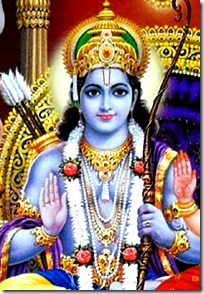
The poet also asks that Shri Rama be his strength. Again, depending on the body type, different objects serve as fuel. The strength for the tiger is the animal flesh that it eats. For the teacher, his strength is the knowledge he acquires, for without it he couldn’t teach others. The source of strength is what sustains us, so by asking that Rama, through His name, be his only strength, Tulsidas doesn’t want to ever consider anything else as being the source of his existence, his reason for living. He wants that if he has to live, the source of his life breath, what gets him out of bed every morning, should be Rama and His name.
“But ignorant and faithless persons who doubt the revealed scriptures do not attain God consciousness. For the doubting soul there is happiness neither in this world nor in the next.” (
Lord Krishna, Bg. 4.40)
The poet also asks to have full faith in the name of Rama. Having faith in someone means that you trust them to deliver what they promise. Since Rama will be his reliance and his strength, Tulsidas wants that he have firm faith in his surrendering to God. Full surrender actually cannot happen without faith, for if we have doubts, the level of satisfaction received and the benedictions provided by the bhakti process will be checked. Indeed, the level of the resulting satisfaction is linearly related to the degree of surrender accepted by the devotee. Having faith in Rama’s name is also a very nice gesture on the worshiper’s part, as it shows that the promises made by the Lord and the prescriptions presented by both Him and His followers are accepted without reservation.
Though he didn’t need to add this part, Tulsidas mentions just why anyone would want the three things he has asked for. Remembering the name of Rama brings all auspiciousness, well-being and fortunes. Those who regularly recite the holy names of the Lord, such as those found in the sacred maha-mantra, “
Hare Krishna Hare Krishna, Krishna Krishna, Hare Hare, Hare Rama Hare Rama, Rama Rama, Hare Hare”, are never losers. How can someone who is in contact with the Supreme Soul, the person to whom the individual soul is naturally attached, ever be bereft of anything? The poor man is he who has no knowledge of the holy name and the benefits it brings to those who recite it.
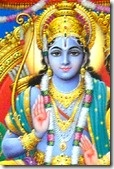
The holy name of Rama transcends the boundaries of thought and endeavor because it is a direct representation of the Supreme Lord. We may chant the name of our beloved or the name of a particular object, but doing so will not bring us their association. But since God is absolute, His name is as powerful as His personal presence. This secret was well known to Tulsidas, and since he was deserving of so much, he made sure to ask his beloved Rama for the only worthwhile benediction. Just as the poet’s wish was to only have reliance on the holy name, our wish is to only have faith, reliance and strength in the poet’s wonderful works, for through them the power of bhakti and the benevolence of its beneficiary are revealed.
In Closing:
For three simple things are all he is asking,
Tulsidas the poet, Rama he is beseeching,
To have faith in the Lord’s holy name and in Rama trust,
Have strength in Rama, who makes even the weak robust.
Poet so popular that his influence so strong,
That others present theories of him that are wrong.
His real take on life is given for all to see,
Divine love is real business, of bhakti he is trustee.
Paths towards salvation Vedas do give many,
But bhakti is complete, equal it does not have any.
Follow full faith in Rama’s name, in it have no doubt,
From reciting it, Rama’s qualities in mind do sprout.
The holy name brings fortune and auspiciousness,
Well-being too, relief from constant sadness.
To bhakti principles give full compliance,
And in Rama’s holy name have full reliance.
 “Tulsidas humbly asks to have trust in Rama, to take strength in Rama, and to have complete faith in Rama’s holy name, the remembrance of which brings auspiciousness, well-being and fortunes.” (Dohavali, 38)
“Tulsidas humbly asks to have trust in Rama, to take strength in Rama, and to have complete faith in Rama’s holy name, the remembrance of which brings auspiciousness, well-being and fortunes.” (Dohavali, 38) How can the poet’s teachings be interpreted otherwise? The Vedas, which are the original spiritual tradition of India dating back since time immemorial, provide different roadmaps towards ultimate salvation, the emancipation of the soul. Though religions today are often associated with dogmas, sectarian principles and sentimentalist traditions, the process of genuine self-realization can be described in scientific terms. Therefore the original Vedas never touch on different factions, for the concept of “
How can the poet’s teachings be interpreted otherwise? The Vedas, which are the original spiritual tradition of India dating back since time immemorial, provide different roadmaps towards ultimate salvation, the emancipation of the soul. Though religions today are often associated with dogmas, sectarian principles and sentimentalist traditions, the process of genuine self-realization can be described in scientific terms. Therefore the original Vedas never touch on different factions, for the concept of “ Though the specific practices implemented from a spiritual education can be many, the Vedas place them into three primary groups. One method is to follow fruitive activity and sacrifice the results to the object of worship, the Supreme Lord. The individual soul’s ultimate characteristic is to be a lover of God, and God’s position is to be loved. He too is spirit, but the quantitative presence of His features is much larger. He is the big soul, or Supersoul, while we are individual souls. In karma-yoga, the results of actions that normally benefit the body of the individual soul are sacrificed for the benefit of the Supreme Lord. Detachment steadily increases and the worker ideally realizes that their business is to serve God and no one else.
Though the specific practices implemented from a spiritual education can be many, the Vedas place them into three primary groups. One method is to follow fruitive activity and sacrifice the results to the object of worship, the Supreme Lord. The individual soul’s ultimate characteristic is to be a lover of God, and God’s position is to be loved. He too is spirit, but the quantitative presence of His features is much larger. He is the big soul, or Supersoul, while we are individual souls. In karma-yoga, the results of actions that normally benefit the body of the individual soul are sacrificed for the benefit of the Supreme Lord. Detachment steadily increases and the worker ideally realizes that their business is to serve God and no one else. The third pathway is actually the culmination of every other system of maintenance. Bhakti-yoga is all-inclusive, as yoga is meant to result in pure love for God. For those who are already on the platform of pure love for Godhead, there is no need to explicitly practice any other type of yoga. Goswami Tulsidas was a proponent of bhakti-yoga, as he was practicing it all the time. What’s so wonderful about loving God is that when you act out your love, you don’t even consider that you are doing yoga. Since it is the dharma of the soul to be a lover of God, when activities are driven by this characteristic, there is no consideration given to the type of engagement adopted or the meaning behind it. In the spiritual world, where the influence of maya is absent, there is no such thing as bhakti, karma, or jnana. Everyone loves God, so there is no divergent behavior that can introduce distinctions. Darkness is there when light is absent, but if we had constant full illumination, we could never properly understand darkness. Similarly, when there is only love for God, there is no consideration given to self-realization, matter, or spirit.
The third pathway is actually the culmination of every other system of maintenance. Bhakti-yoga is all-inclusive, as yoga is meant to result in pure love for God. For those who are already on the platform of pure love for Godhead, there is no need to explicitly practice any other type of yoga. Goswami Tulsidas was a proponent of bhakti-yoga, as he was practicing it all the time. What’s so wonderful about loving God is that when you act out your love, you don’t even consider that you are doing yoga. Since it is the dharma of the soul to be a lover of God, when activities are driven by this characteristic, there is no consideration given to the type of engagement adopted or the meaning behind it. In the spiritual world, where the influence of maya is absent, there is no such thing as bhakti, karma, or jnana. Everyone loves God, so there is no divergent behavior that can introduce distinctions. Darkness is there when light is absent, but if we had constant full illumination, we could never properly understand darkness. Similarly, when there is only love for God, there is no consideration given to self-realization, matter, or spirit. Tulsidas knows that the Lord grants the wishes of those who have no desire to serve Him. If even the people driven by desires in karma, or fruitive activity, get the benefits or punishments that are due them, we can just imagine how much more seriously the desires of the devotees are taken. Tulsidas was very famous during his time, as his
Tulsidas knows that the Lord grants the wishes of those who have no desire to serve Him. If even the people driven by desires in karma, or fruitive activity, get the benefits or punishments that are due them, we can just imagine how much more seriously the desires of the devotees are taken. Tulsidas was very famous during his time, as his  The poet also asks that Shri Rama be his strength. Again, depending on the body type, different objects serve as fuel. The strength for the tiger is the animal flesh that it eats. For the teacher, his strength is the knowledge he acquires, for without it he couldn’t teach others. The source of strength is what sustains us, so by asking that Rama, through His name, be his only strength, Tulsidas doesn’t want to ever consider anything else as being the source of his existence, his reason for living. He wants that if he has to live, the source of his life breath, what gets him out of bed every morning, should be Rama and His name.
The poet also asks that Shri Rama be his strength. Again, depending on the body type, different objects serve as fuel. The strength for the tiger is the animal flesh that it eats. For the teacher, his strength is the knowledge he acquires, for without it he couldn’t teach others. The source of strength is what sustains us, so by asking that Rama, through His name, be his only strength, Tulsidas doesn’t want to ever consider anything else as being the source of his existence, his reason for living. He wants that if he has to live, the source of his life breath, what gets him out of bed every morning, should be Rama and His name. The holy name of Rama transcends the boundaries of thought and endeavor because it is a direct representation of the Supreme Lord. We may chant the name of our beloved or the name of a particular object, but doing so will not bring us their association. But since God is absolute, His name is as powerful as His personal presence. This secret was well known to Tulsidas, and since he was deserving of so much, he made sure to ask his beloved Rama for the only worthwhile benediction. Just as the poet’s wish was to only have reliance on the holy name, our wish is to only have faith, reliance and strength in the poet’s wonderful works, for through them the power of bhakti and the benevolence of its beneficiary are revealed.
The holy name of Rama transcends the boundaries of thought and endeavor because it is a direct representation of the Supreme Lord. We may chant the name of our beloved or the name of a particular object, but doing so will not bring us their association. But since God is absolute, His name is as powerful as His personal presence. This secret was well known to Tulsidas, and since he was deserving of so much, he made sure to ask his beloved Rama for the only worthwhile benediction. Just as the poet’s wish was to only have reliance on the holy name, our wish is to only have faith, reliance and strength in the poet’s wonderful works, for through them the power of bhakti and the benevolence of its beneficiary are revealed.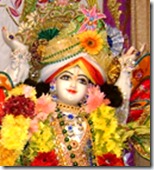 “When the Lord was on the lap of His mother, He would at once stop crying as soon as the ladies surrounding Him chanted the holy names and clapped their hands. This peculiar incident was observed by the neighbors with awe and veneration.” (Shrila
“When the Lord was on the lap of His mother, He would at once stop crying as soon as the ladies surrounding Him chanted the holy names and clapped their hands. This peculiar incident was observed by the neighbors with awe and veneration.” (Shrila 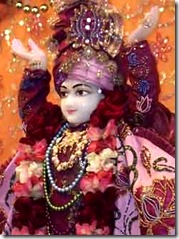 What is Vaikuntha? An area free of anxiety is the definition of the word, but the proper noun specifically refers to the spiritual land inhabited by the personal form of the Lord. God is one, but depending on how His mercy is viewed and utilized, the understanding from the target individual’s perspective can vary. At the very bottom of the ladder of understanding, there is no direct perception of God. Rather, the results of spiritual action are taken to be the causes themselves. For instance, we’ll see the sun rising and setting and the clouds pouring rain down onto land and take such forces to be the beginning and end. Or worse, we’ll think that we can manipulate these gifts of nature to increase our own position. Once a satisfactory ascendency is reached, we’ll declare ourselves to be supreme.
What is Vaikuntha? An area free of anxiety is the definition of the word, but the proper noun specifically refers to the spiritual land inhabited by the personal form of the Lord. God is one, but depending on how His mercy is viewed and utilized, the understanding from the target individual’s perspective can vary. At the very bottom of the ladder of understanding, there is no direct perception of God. Rather, the results of spiritual action are taken to be the causes themselves. For instance, we’ll see the sun rising and setting and the clouds pouring rain down onto land and take such forces to be the beginning and end. Or worse, we’ll think that we can manipulate these gifts of nature to increase our own position. Once a satisfactory ascendency is reached, we’ll declare ourselves to be supreme.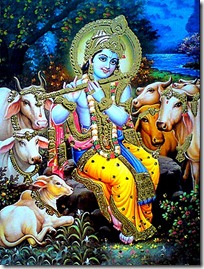 Again, this understanding comes from how the reflection of God’s potencies are realized. In this understanding there is no knowledge of the Personality of Godhead, nor what He looks like, nor what His relationship to the living entities is. With the Vedas, the authorized scriptural tradition emanating from India, there is much more evidence provided about God and His energies. In the Vedas the potency of the Supreme Spirit is reflected almost completely, without any degradation in signal. If we relay a specific network connection across many hops, there will be a delay and an increased chance of packet loss. This is why if we’re connecting to a website hosted across the globe, there is increased latency in the connection.
Again, this understanding comes from how the reflection of God’s potencies are realized. In this understanding there is no knowledge of the Personality of Godhead, nor what He looks like, nor what His relationship to the living entities is. With the Vedas, the authorized scriptural tradition emanating from India, there is much more evidence provided about God and His energies. In the Vedas the potency of the Supreme Spirit is reflected almost completely, without any degradation in signal. If we relay a specific network connection across many hops, there will be a delay and an increased chance of packet loss. This is why if we’re connecting to a website hosted across the globe, there is increased latency in the connection.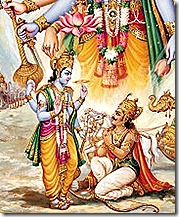 Lord Chaitanya Mahaprabhu’s advent was one of those special occasions. In previous eras, Krishna came to deal with miscreants and evil elements. The saintly class of men will always be around in society, though their level of prominence may vary. Even if the saints are well represented, there will always be evil elements looking to diminish their influence. If the saintly class faces too much harassment, Krishna comes to the scene to do away with the inhibitors. By providing such protection, the principles of real religion are maintained.
Lord Chaitanya Mahaprabhu’s advent was one of those special occasions. In previous eras, Krishna came to deal with miscreants and evil elements. The saintly class of men will always be around in society, though their level of prominence may vary. Even if the saints are well represented, there will always be evil elements looking to diminish their influence. If the saintly class faces too much harassment, Krishna comes to the scene to do away with the inhibitors. By providing such protection, the principles of real religion are maintained.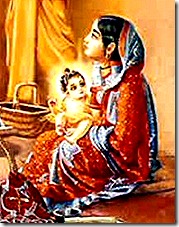 The word hari can mean “lion”, “monkey”, or “one who removes distresses”. It is one of Krishna’s most famous names because of His ability to remove distresses from His devotees. Lord Chaitanya and His associates, like His elder spiritual brother Lord Nityananda, would make the exclamation, “Haribol”, famous through their preaching. This simple expression begs others to chant the names of Hari, just as the mothers caring for young Nimai did.
The word hari can mean “lion”, “monkey”, or “one who removes distresses”. It is one of Krishna’s most famous names because of His ability to remove distresses from His devotees. Lord Chaitanya and His associates, like His elder spiritual brother Lord Nityananda, would make the exclamation, “Haribol”, famous through their preaching. This simple expression begs others to chant the names of Hari, just as the mothers caring for young Nimai did.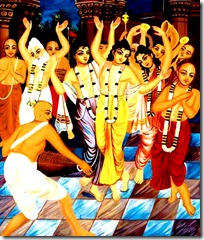 For His behavior, for His characteristics, for His ability to be pleased only by hearing Krishna’s names, Lord Chaitanya garnered respect right from the time of His birth. He would go on to spread the glories of Krishna-kirtana throughout India. The best way to honor Him is to regularly chant Krishna’s names in the same way that the residents of Navadvipa did in His youth. Lord Chaitanya begs everyone to find their constitutional position as servant of God. He sheds tears of sadness seeing the condition of the fallen souls in the Kali Yuga, and He bursts with affection when He sees anyone sincerely singing the glories of the beloved Hari.
For His behavior, for His characteristics, for His ability to be pleased only by hearing Krishna’s names, Lord Chaitanya garnered respect right from the time of His birth. He would go on to spread the glories of Krishna-kirtana throughout India. The best way to honor Him is to regularly chant Krishna’s names in the same way that the residents of Navadvipa did in His youth. Lord Chaitanya begs everyone to find their constitutional position as servant of God. He sheds tears of sadness seeing the condition of the fallen souls in the Kali Yuga, and He bursts with affection when He sees anyone sincerely singing the glories of the beloved Hari.

















